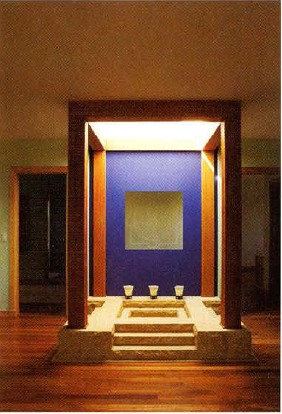|
|
|
| Iowa Shangri-la July/August 2005 |
by Linda Egenes |
| The state’s newest town is also one of its most innovative, from urban design to environmental and spiritual health. Come, explore Maharishi Vedic City this summer. | |
|
|
SPOTLIGHT MAHARISHI VEDIC CITY Driving south on Highway 1 through the farmlands and towns of southeast Iowa’s prairie landscape, you may notice a few exotic-looking spires and golden rooftops floating above the cornstalks. It is not a mirage; it is Maharishi Vedic City, the state’s newest town. Maharishi Vedic City, incorporated in 2001, derives its name from the Vedic principles brought to light by Maharishi Mahesh Yogi, founder of transcendental meditation. “Veda means knowledge,” says the city’s director of economic development, Dr. Kent Boyum. “Everything in the city is designed to use Vedic principles of architecture, health and education to increase the good fortune of its citizens.” You can experience the city’s vision for yourself August 20–21 and August 27–28 when homeowners open their doors for the town’s Festival of Homes, which includes a self-guided tour of homes, a tour of the city’s organic greenhouse and the nearby Vedic Observatory, an arts fair and an organic food market. FACE THE RISING SUN “Orienting the homes to the east is an important design principle of Maharishi Vedic architecture,” says Jonathan Lipman, an architect who designed some of the city’s buildings. Other Vedic design features, such as the gold-colored kalash (“vessel” in Sanskrit) topping each building, connect the individual home to the cosmos. Each building also is surrounded by a vastu, or homesite, which is usually rectangular or square and has an entrance to the east. An ordinary fence of wood, metal or stone delineates the edges of the vastu, although its dimensions >> |
 Organic vegetables from the Maharishi Vedic City Agricultural Greenhouse. |
are calculated to create a harmonious
relationship between the homeowner and the sun, moon and planets. Like the fence styles, the
home’s physical architectural styles vary widely, from Victorian revival to classical to
modern. The Vedic tradition is evident in the placement of rooms, their dimensions, the
slope and shape of the land and the location of bodies of water.
“What we are creating is an entire city that repels negative influences,” says Lipman. “To me it’s the most extraordinary experiment happening in the field of urban design.” Near the city’s east entrance, Lipman designed a New York-style condo on the top floor of a three-story red brick commercial building. Open for touring, his home’s design includes expansive prairie vistas, a variety of wall finishes, including plasters and clay and sand paints using 19th-century techniques, plus a colorful Tibetan rug collection.
|
Looking north from Lipman’s living room you
can see the Mandala One Village. Mandala One, which is now 40 percent developed, includes 15
homes inspired by the early 20th-century Arts and Crafts Movement. With clapboard siding in
pastel colors, white picket fences and front porches, it looks like an idealized small town
straight from The Music Man.
South of the city, author and entrepreneur Fred Gratzon’s 10,000-square-foot home is an eclectic blend of Japanese roofs, Corinthian columns and Spanish tile. Like other homes, it includes a Brahmasthan, a central area that serves as a building’s silent core. Here, Fred, his wife, Shelley, and their 16-year-old son, Jake, practice transcendental meditation, which is believed to improve health, increase mental clarity and enhance relationships. To tour a building on a larger scale, drive to the north side of the city to
|
| the Rukmapura Park Hotel, a 25-room wood
structure in the tradition of European country inns. The songs of meadowlarks and the
honking of geese greet visitors from the bird sanctuary and estuary below the hotel.
Dee Johnson and her husband, Chris, developed this 240-acre resort that includes their own home and 24 others built around two lakes. They moved from San Francisco to Iowa with their two young sons 15 years ago, and were soon joined by Chris’ parents. “With Maharishi Vedic architecture,” she says, “there’s an accumulation of coherence and silence that works together, removing resistance to your desires. It’s as close to heaven as you can be.” VEDIC VEGETABLES After a busy morning touring homes, try a 16-dish organic vegetarian buffet at The Raj Maharishi Ayur-Veda Spa |
Center and hotel. Set at the end of a grand
driveway lined by Bradford pear trees, the French Provincial-style facility is garnering
attention as a top spa.
“We’ve gained international recognition for our authentic and holistic rejuvenation treatments from the world’s most ancient tradition of natural medicine,” says Jocelyne Comtois, marketing director. “Because we maintain three staff for every client, guests feel deeply nourished and cared for.” The Raj tour includes a peek inside a private treatment suite, where day guests can indulge in facials, anti-stress massages and other relaxing treatments. The 100-acre estate also features rose gardens, a lake with swans and nature trails. For a lighter lunch, sample the offerings at the food fair located outside The Raj alongside the arts fair and farmers’ market. All food sold inside the city is organic, because of a city ordinance. |
 A view of the Brahmastan for Maharishi Vedic City resident David Hanson's home. |
|
|
||
| To tour the 160-acre Maharishi
Vedic City Organic Farm, drive six miles north to 140th Street. Inside the vast 1.2-acre
certified organic greenhouse, plots of rainbow chard, red-leaf lettuce, fennel and other
vegetables carpet the floor like a vast patchwork quilt. In June, the greenhouse celebrated
its first year of production, and was able to distribute its products to markets in Des
Moines, Iowa City and even Chicago.
The greenhouse eventually will cover 70 acres and is an important part of the city’s green agenda, which is also evident in the lack of streetlights and utility poles. In addition, the city’s master plan calls for only electric cars inside the city. “Maharishi Vedic City has voted to eventually own its own utilities to provide off-the-grid power using wind and solar panels,” says Boyum, who has garnered nearly $500,000 in grant monies from state and federal agencies. As a start, this summer two 10-kilowatt Bergey wind turbines and photovoltaic solar panels will be established to power the greenhouse. A VIEW OF THE STARS One of the unique features of the city is the open-air Vedic Observatory, a group of 10 white concrete-and-marble astronomical instruments, each 6 feet tall. While they are precisely aligned with the sun, stars and moon, and could be MORE INFORMATION For more information on the Festival of Homes or to schedule a private tour, telephone 641-470-7070, or visit www.maharishivediccity.net. |
used to calculate their
movements, they also could enliven inner happiness and balance your physiology, says Tim
Fitz-Randolph, the developer who oversaw the observatory’s design and building.
The city has applied for a grant to develop the observatory as a tourist attraction. Plans include a $1.2 million marble visitor center, landscaping and a tower for viewing the entire observatory. With all of these attractions and more coming, Boyum invites “everyone to come and experience what we have to offer.” Linda Egenes is author of six books. She lives near Maharishi Vedic City in Fairfield. Photography by Rick Donhauser WHERE TO STAY & EAT
|
|